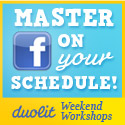Branding will help you sell more books.
I’m usually not the kind of blogger who makes a big statement like that, but there it is. Why do I feel like I can make it? It’s simple:
If people know your name, they’re more likely to buy your books.
Think about it – it sounds like common sense, but it’s true. While a few of us search out undiscovered talent, the vast majority are likely to buy that Stephen King novel versus that dude nobody’s heard of sitting next to him on the shelf. This is even more important in self-publishing where you’re competing not just against other traditionally published authors, but also against everyone that’s ever written a book. Ever. But don’t panic! This is where branding comes in.
Now there are a lot of marketing experts out there who will tell you it takes a ton of time, money, and research to build a brand for yourself, and they’re not incorrect. The problem is that most authors going through the self-publishing process are not in excess of time, money, or research. While the advice in this post may not be able to build you a brand like Nike or McDonalds for less than the cost of a pair of shoes or some hamburgers, we can help you get started and thinking about the concept, including how you can capitalize on it to sell books. Hey, we can always give you some extra help down the road if you need it.
What the heck is branding? How can it help an author like me?
To keep it simple, branding is all of the thoughts, feelings, perceptions and expectations associated with you, whether we’re talking about you as in your personal name as a novelist (or non-fiction writer) or you as in your business/organization name as a business author.
McDonalds is the classic example. As far as I’m concerned, I don’t think it’s a contest that McDonalds does not have the best food in the world. When I go into a McDonalds, however, I do know exactly what to expect: cheap food prepared decently fast by unenthusiastic employees that usually doesn’t have a human fingernail in it [WARNING: do NOT follow that link if you ever plan to eat fast food again]. These thoughts and feelings make up my personal perception of McDonalds’ brand.
All perceptions are not created equal. There are tons of people that hate McDonalds with a venomous passion I thought was only reserved for overseas soccer matches and discussions about Tim Tebow. The good part for McDonalds is that they don’t care. Rather, they don’t have to care. For every person that hates McDonalds, there are 50 people who will eat there daily, happily scarfing down everything from Big Macs to McFlurries.
Hopefully, no matter what type of author you are, you don’t have to deal with that kind of polarizing perception. The good news is that you’re not McDonalds, with fifty-plus years of perception following you around. You can start fresh and craft your brand from the ground up to be whatever you want it to be, and if you get to be as big as McDonalds (or Stephen King or Nicholas Sparks or Stephenie Meyer), you won’t have to give a crap if a few people hate you, too.
5 easy tips to start building your brand
- Discover your brand. Write down 5 adjectives you think describe yourself and 5 that don’t. These will make up the things you want people to think about you (and what you don’t).
- Make yourself unique. You know the saying: jack of all trades, master of none. Figure out what makes your writing unique! Nicholas Sparks figured this out early: write commercially marketable, sappy love stories revolving around simplistic but likable characters, one of whom will always meet some sort of horrible and/or tragic end. If mystery is involved, bonus points.
- Write your elevator pitch. Now that you know your niche (what makes you unique) pare it down to a punchy sentence or two! Try to incorporate the adjectives we discovered in step one, but be sure it’s meaningful, not just empty words, ie “I use my unique experience as a meteorite hunter to craft witty space novels revolving around aliens from the planet Xoron.” If you said that to someone on an elevator, you know they’d immediately want to know more. Or think you were very strange. Either way, you’d get their attention.
- Make friends with a graphic designer. Seriously, it will make the process much easier, because the next step is to make your brand a physical reality. A designer will help by talking to you about the correct colors, typography and design elements to bring your brand to life. Create business cards, letterhead, a resume, a website, a blog, a Twitter account — all with the same consistent look and feel.
- Put your brand into practice. Armed with a clear picture of who you are, how you want people to see you, and the tools to make it happen – well, make it happen! Whenever you write, make an appearance, blog, comment, talk to people on the street, make sure you incorporate your brand. You don’t have to begin every discussion/post/conversation/tweet with “Hi, I’m Chuck. I use my unique experience as a meteorite…” but if you want people to think of you as witty – be witty! If you want people to think of you as emo – be emo! It won’t be possible 100% of the time, but if you’re more consistent than not, you’re on the right track.
Hopefully these tips will get you started down your personal brand development path, but if you get stuck, let us know! We’ll bring over the 4-wheel drive truck to get you out. Yeah, that was corny. Definitely not witty. [Branding FAIL!]
It’s your turn
Have you cemented your brand? Think branding is for losers? Want to know more about the planet Xoron? Let us know in the comments!



 We're
We're 








